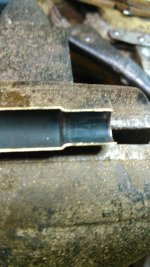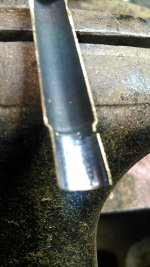jimbires
Handloader
- Aug 16, 2011
- 3,156
- 1,865
truck driver":10cq9rq6 said:I'm going to split a case into and see if I can see the problem from the inside since I have several that have not lost the necks. That should show the crack forming in the crease at the bottom of the shoulder and neck.Elkman":10cq9rq6 said:rodger i believe you have it right, from the photos its looks like that the failure occurs right along that line. I have seen other improved cases fail along the same line. It's got to be a weak area and resizing makes it fail faster than would be consistent with a standard case.I measured a standard case neck and from base to mouth it was .438" while the AI case neck was .464" so you're looking at .026" difference. I believe the case failure is caused by the shoulder being set back to form the 40* shoulder.
I'll be interested in hearing what you find, when you cut a case . please let us know .









